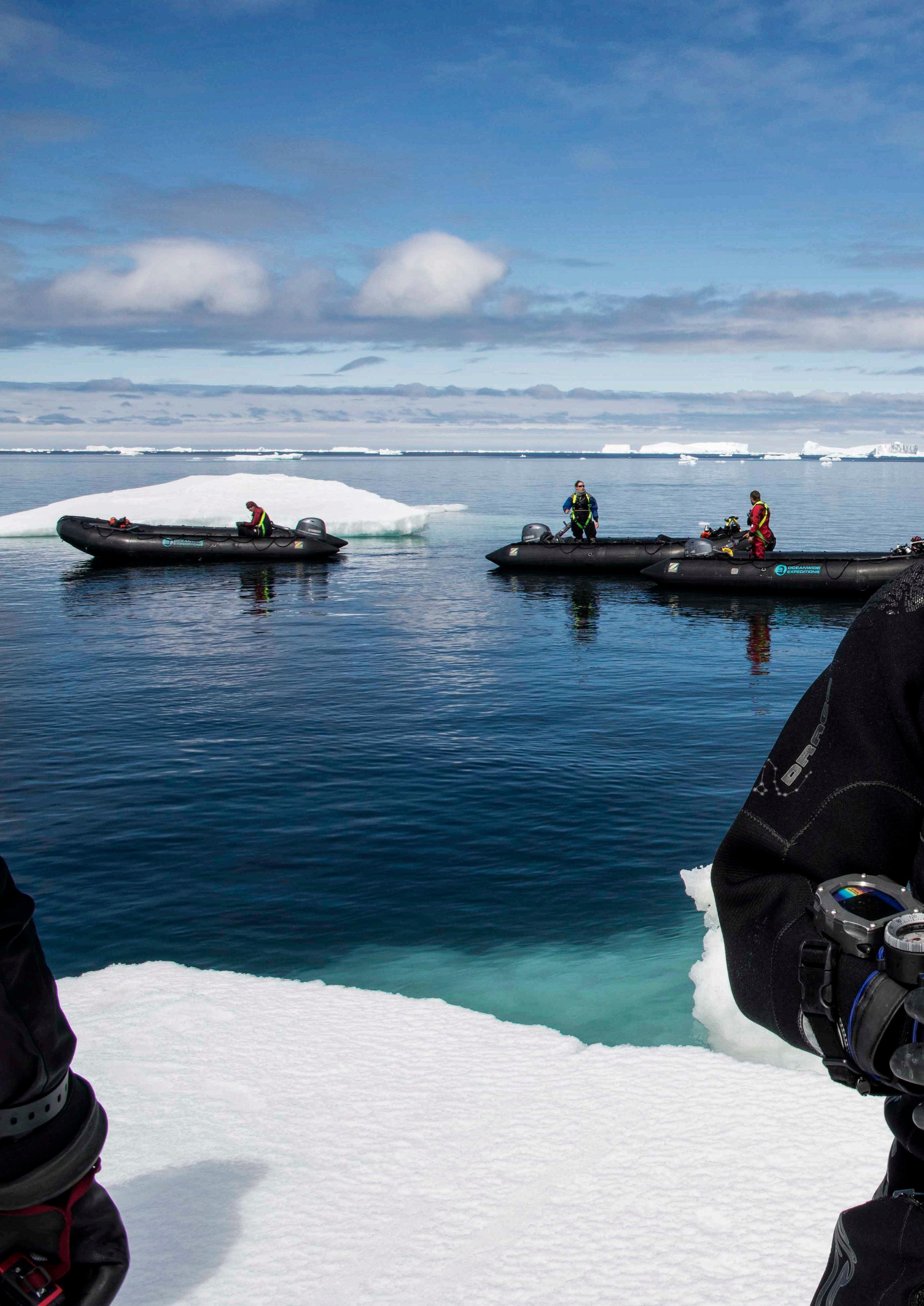
18 minute read
Diving on the Seventh Continent
FEATURE AND PHOTOGRAPHY RAF JAH
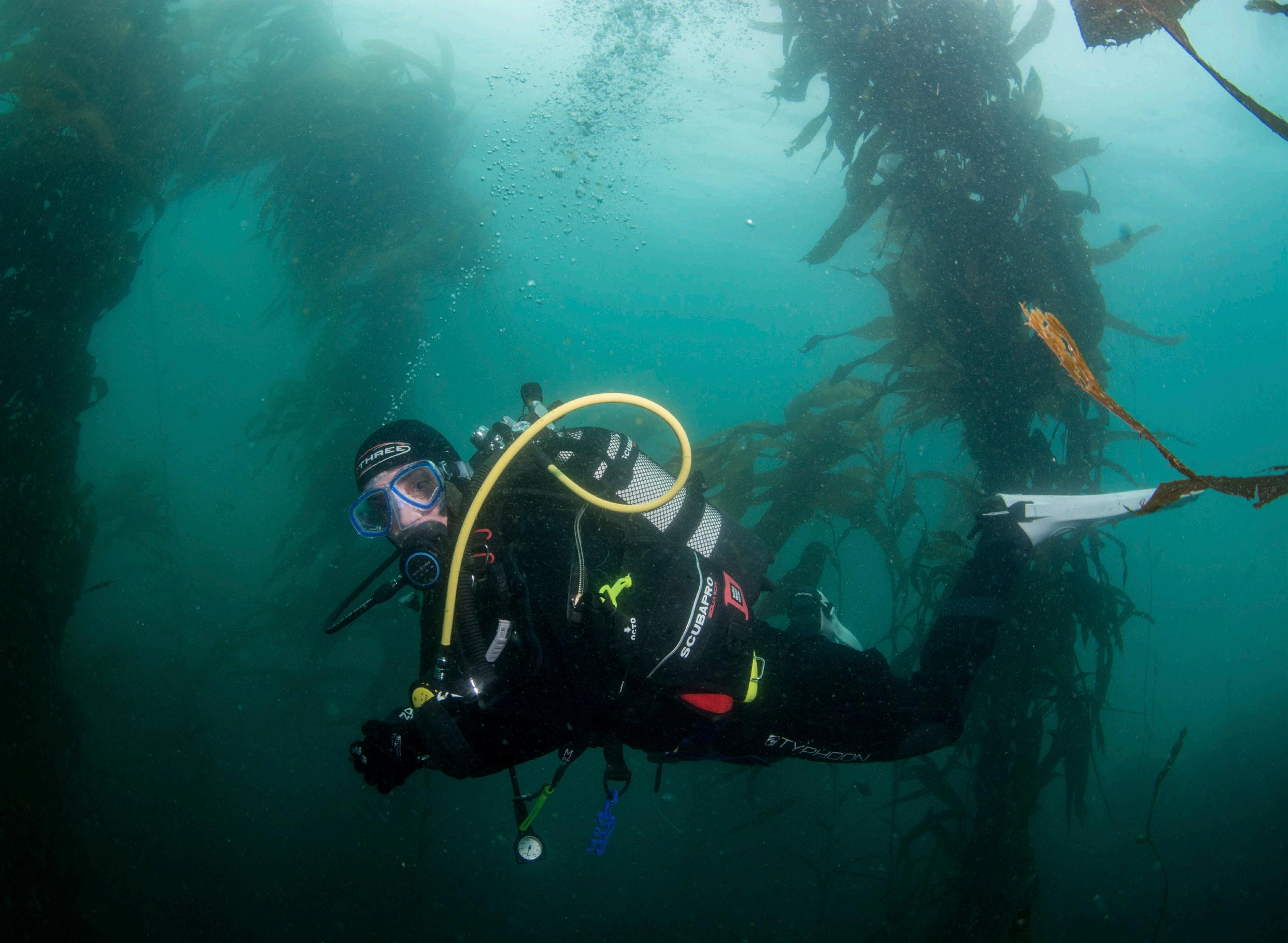
Francisca on our first dive at Carcass Island.
Advertisement
Just getting to the start of an Antarctic dive expedition is a journey in itself. The divers from Dubai had to spend 18 hours on an Emirates Boeing 777 to get to Buenos Aires. Then after a night in the city, a 3½ hour flight on a Boeing 737 brought us to the southern tip of South America and the town of Ushuaia and a mandatory two-night halt in case our baggage had chosen a different route. We were now within 100 miles of Cape Horn and the southernmost tip of South America.
Ushuaia was an over-priced series of ugly hotels and restaurants set on the side of a hill. Most of us wandered around the streets trying to make sure that our legs worked, stopping in cafes to drink real coffee while looking out at the Beagle Channel with Chile as the backdrop.
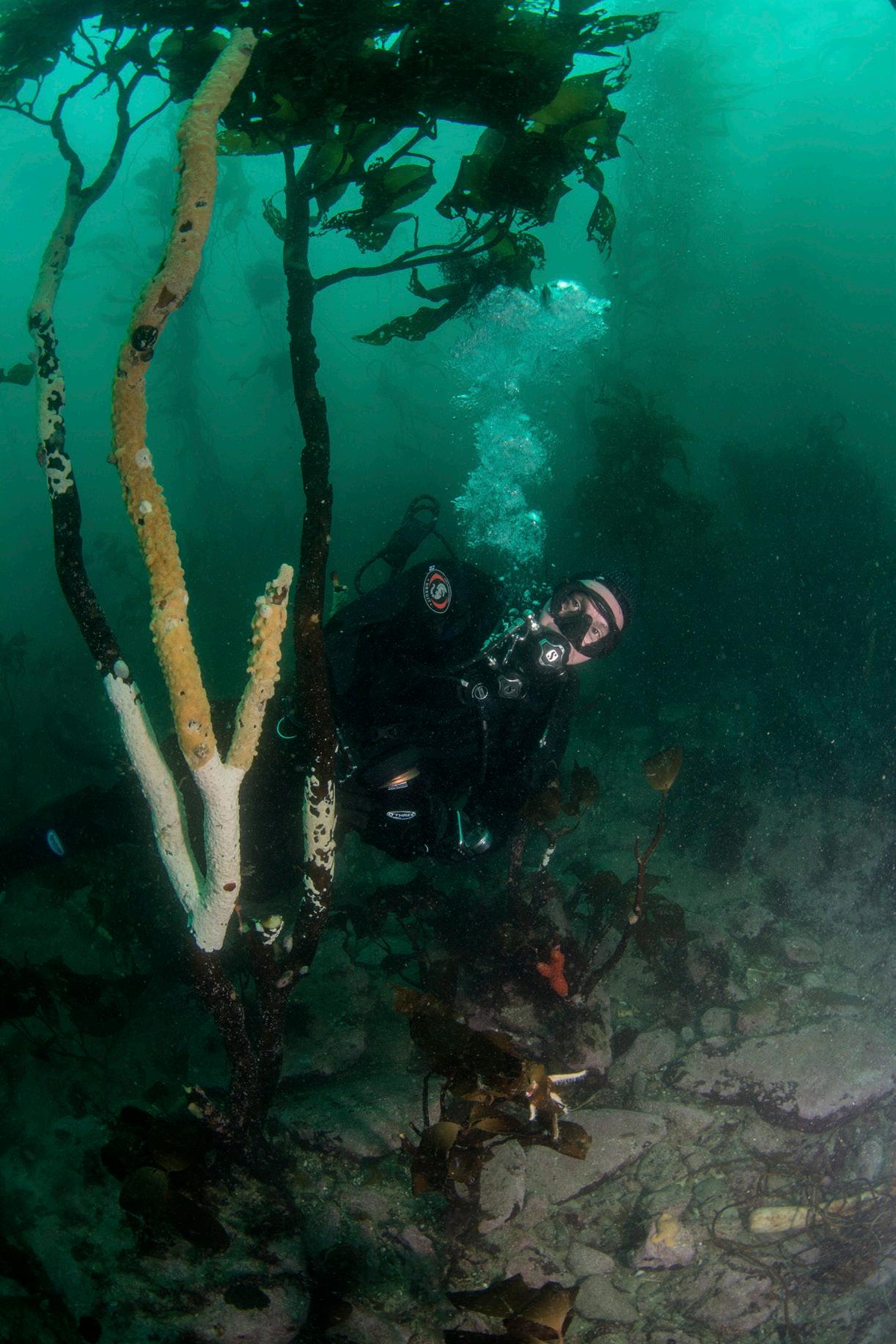
Stevie Macleod away from his work bench at Al Boom and diving in South Georgia.
Boarding the MV Plancius didn’t go as planned and we had to wait in town until 4 pm as our departure had been delayed due to a sick crew member. So we hung around Ushuaia, drinking coffee and waiting for news. What we didn’t know was that the Argentine health authorities wanted to quarantine the ship for two weeks. Thankfully, the ship’s agent managed to negotiate mass inoculation instead. We all met up to hear the expedition leader and her deputy explain that all was well and we could now be bussed to the ship.
With no idea about what really went on, we felt slightly uneasy, but were soon steaming out of Ushuaia while having our safety briefings and dinner. I later went out on deck and stared at Argentina to the north and Chile to the south: the excitement was palpable as skuas and other sea birds circled the ship in the endless twilight.
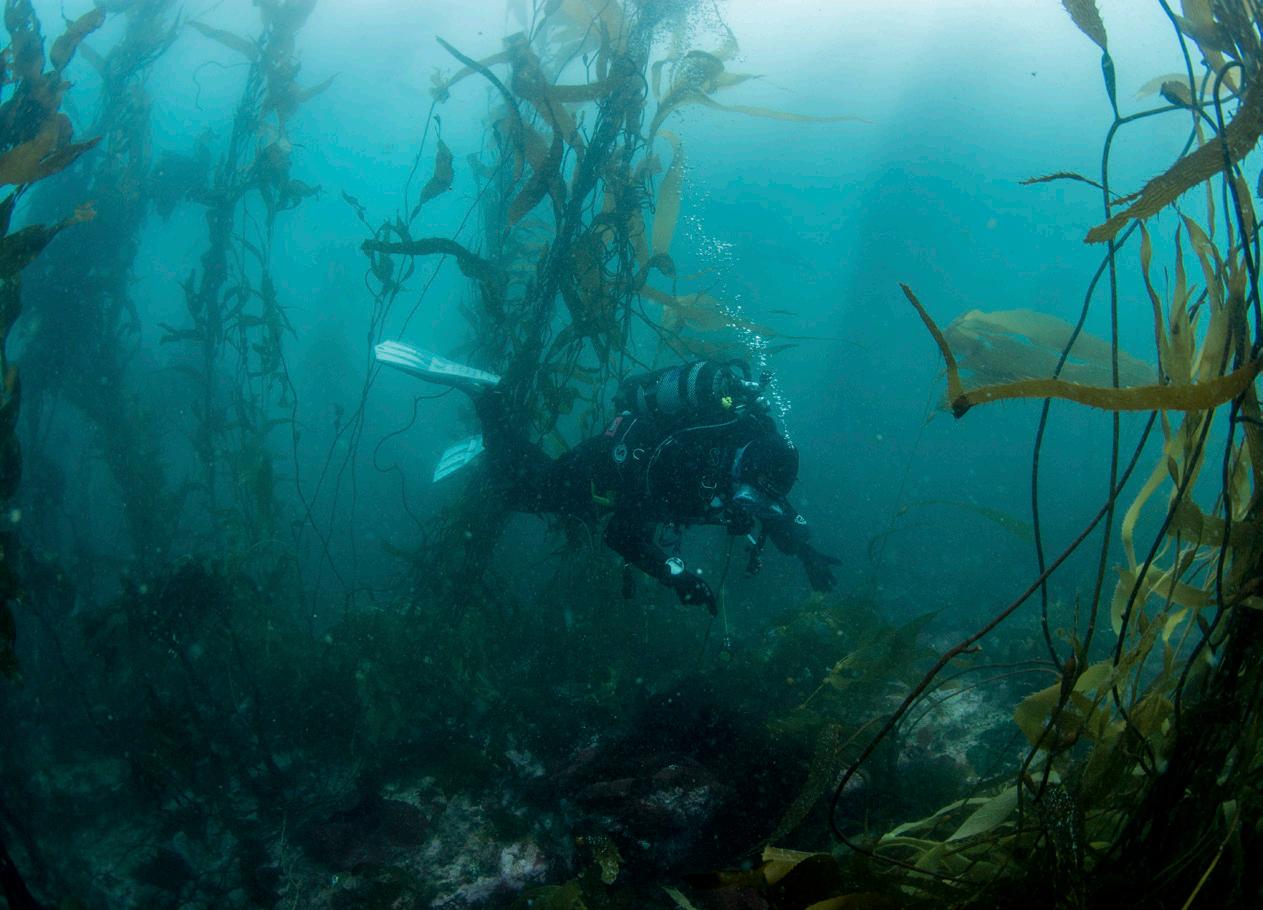
Morning unveiled an unbelievably calm south Atlantic Ocean. We prepared our kit and listened to interminable briefings on everything from how to get boots on to boarding a Zodiac. As divers,most ofthis was old hat,but briefings are vital and compulsory, so we listened closely. More impor tant were the repeated briefings on dive safety procedures. There’s so much that could go wrong that nothing could be left to chance – or worse, assumption. We assembled on the ship’s bow and thoroughly tested our kit. Check, check, check and check again – then take it apart. And while kitting up, a fin whale breached nearthe ship, followed by a pod of orcas ambling alongside.
After lunch, we had a series of lectures of varying quality on the Falkland Islands and geology. A good cruising pace brought us to the following morning, and we steamed around the outer edges of the Falkland Islands. We passed through a gap called Wooley Gut at 0645 hrs, and I stood on the bow and stared down at penguins and dolphins on either side of the vessel.
Our first dives were to be check-out dives. Using a procedure that was to become a habit, we loaded our Zodiac with dive gear, and it was then craned over the side, with our dive guide aboard, by a trio of competent and friendly Filipino crewmen. We embarked via the gangway and within 30 minutes, there were fat, black-and-white Comersons dolphins swimming around our Zodiac.
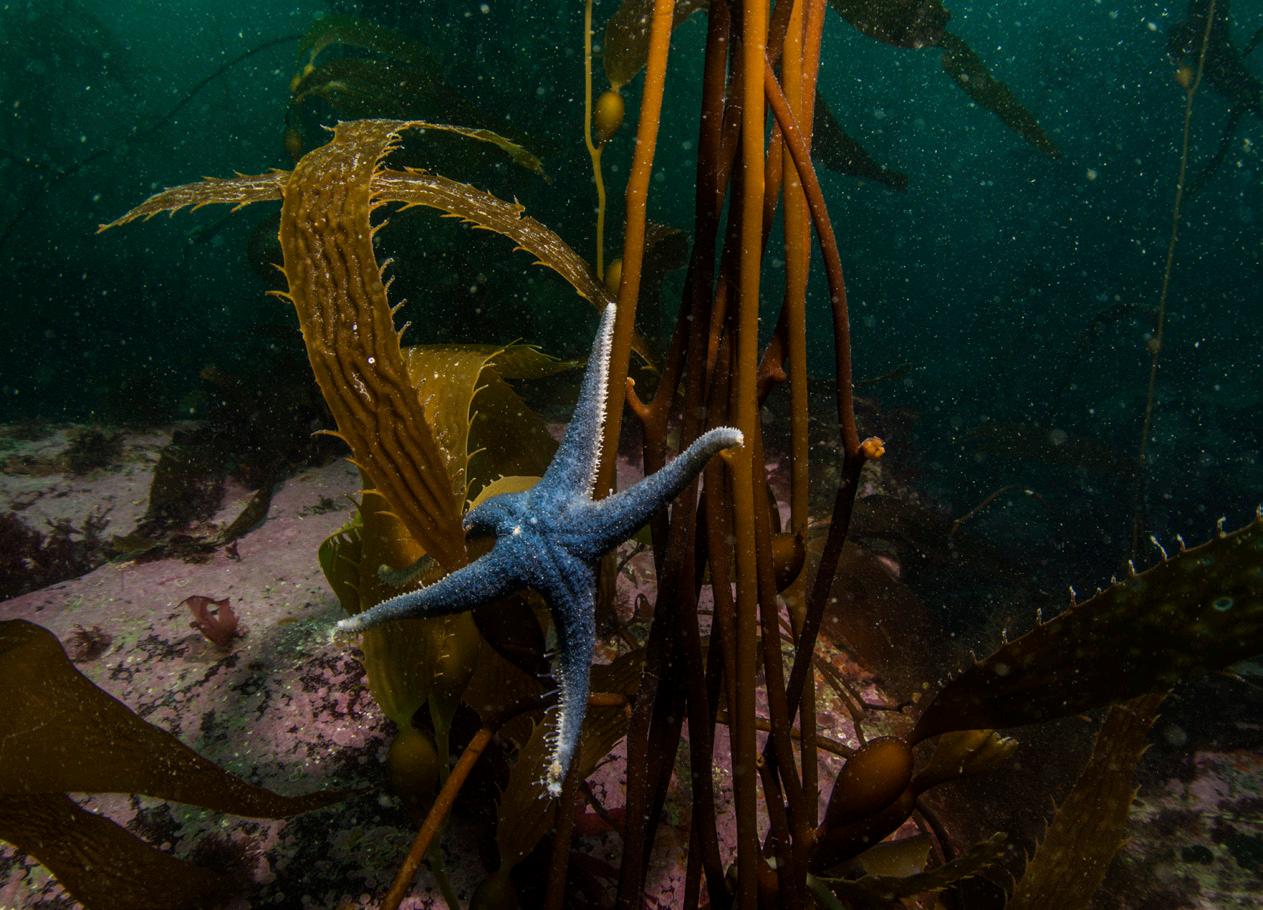
Wherever we looked we would see life, no matter how small.
Excited to get wet, we struggled into our kit and rolled into the water with a depth of about 10 metres. Francisca was my dive buddy, and we checked buoyancy, cameras and general movement before winding our way through the kelp and bore right, seeing crabs, fish and an octopus.The waterwas a pleasant 10˚C,and I was able to dive in 3 mm neoprene gloves.
What amazed me about the Falkland Islands was the sheer amount of sea life down amongst the kelp. Everywhere I looked, I saw a crab or nudibranch or a small fish. We descended to 16 metres, played with some seals, and kept looking because there was something to see everywhere. As is often the way, suddenly our allotted 45 minutes of time were up, we surfaced, and Jerry, the Plancius dive team leader picked us up.
With time to spare, we were landed on a slip way on Carcass Island and we walked in our dry suits to a small settlement which, to my surprise, was operated by friendly Chileans. While I sipped on a welcome mug of tea, I was entertained by Gentoo penguins plus an overflying vulture. But sitting there created an unusual problem: we started to overheat in the sun! Our dry suits and “Weezle” under suits coped well with the South Atlantic Ocean.That was easily fixed by jumping in the nearby bay to shed some heat.
Re-boarding the Plancius, we lunched before arriving at the 'neck' of Saunders Island where we were soon back in the water. We had had our check dives, we had ironed out any kinks, this was real expedition diving, no one had been here before, and every buddy team had to make its own decisions. We reached the rocky bottom at 15 metres and found our way through even thicker, but more bunchy kelp. The visibility was 4 to 6 metres, and wherever I looked, I saw life. Lobster-krill, fish, starfish and multiple nudibranches, made for an excellent dive.
That night, we steamed to Port Stanley, the capital of the Falkland Islands, a charming small town populated by people from around the world, before departing for South Georgia. We broke down our scuba kit to make sure that it wouldn’t be damaged if we hit rough weather.
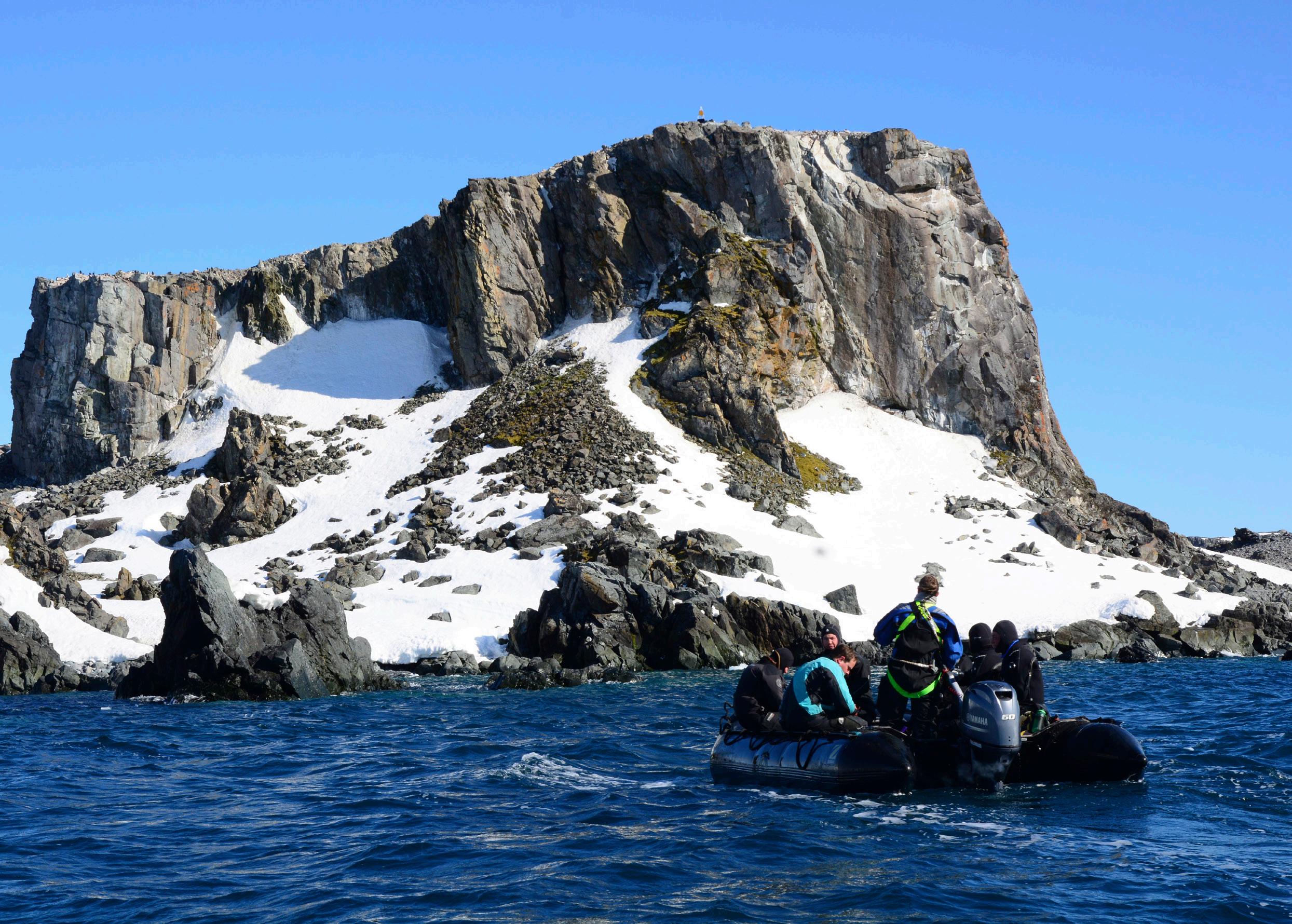
The south shetland islands were our last stop and had the clearest water in Antarctica.
With 20 knot, then 30 and finally 40 knot winds, I thought the sea swell was under 2 m – but the 3rd officersaid it was a 4 metre swell, causing rougher seas. As the Plancius rode the swells, there were yet more lectures, but the weather held as we made good time at a steady 12 knots.
Nearly three days later, we were diving off Tern Island in South Georgia. We had passed the convergence and the water temperature was down to 2 ºC. Our thermal layers were fine, but some of us star ted to suffer cold hands. With fur seals swirling around us and coming up close to say hello, hands were forgotten and we had a magical dive. South Georgia had us alternating diving and landing. Some of the dives were less spectacular than others. Francisca and I went down to enjoy 10-30 cm visibility. We held hands and felt our way along the side of the wall for 10 minutes before binning the dive. The experience was not lost however, as we spent the rest of the time snorkelling with the seals. Later, we landed at coves named Salisbury Plain, Prince Olav’s Harbour, and St Andrews Bay. These were packed with penguins and breeding male fur seals, the latter rather snarly and snappy if anyone ventured too close.
Later in the trip, we dived in the afternoon off a site called Quarry Wall. I was without a buddy and so joined Emirates Divers, Elmar Schanz and Stevie Macleod. Stevie was Dubai’s veteran dive technician, and the only person carrying more spare parts than me. He blew a wrist seal on the dive deck. He replaced it quickly and we thought that all was well until we rolled in off the zodiac. Stevie Surfaced suddenly and shouted: “I’ve water in my suit!”. He swam quickly back to the zodiac and continued, “You two dive together”. There was no time to debate the matter as with 2 º C water in his suit, he had to get out of the water fast.
Elmar and I had never dived together before, but needs must. So we dropped down to 20 metres and moved along the rock wall. We wound our way through the kelp with an occasional communicative nod, and were treated to a plethora of sea stars and small molluscs. We ended the dive after 31 minutes, with seals playing around us in 7 metres of water – all very nice but my video was annoyingly out of focus.

After an evening halt in Grytviken, our last day in South Georgia loomed. The non-divers were offered a Zodiac cruise, but I opted for a gamble dive. If the dive was rubbish, I would snorkel; if it was good, it would be worth it. Francisca decided she just wanted to snorkel, so I ended up diving with Gavin Walker in Coopers Bay.

Divers and non-divers would always meet on land after the dive.
We descended off a small unknown islet and hit the bottom at 12 metres. I hadn't tied my ankle velcro straps tight enough, so I was legbuoyant, and scrabbled around, trying to take photos, stay warm, and maintain some form of level. It was a lot of work, but it was enormous fun as we could see a whole 3 metres! After 24 minutes, I suggested we end the dive as my fingers hurt with the cold. Gavin kindly agreed and we ascended to 3 m, where we dutifully did a 3-minute safety stop. I cursed in my regulatoras my painful fingers screamed at me, and a swell meant we hung onto some kelp to stabilise ourselves. We had descended to 13 metres and lasted for an impressive 27 minutes. Gavin had used 60 bar and I some 120.
As soon as we were done, we had lunch and navigated off through a series of icebergs. South Georgia disappeared as we turned southwest towards the South Orkney Islands. After taking some photos, I was soon asleep.
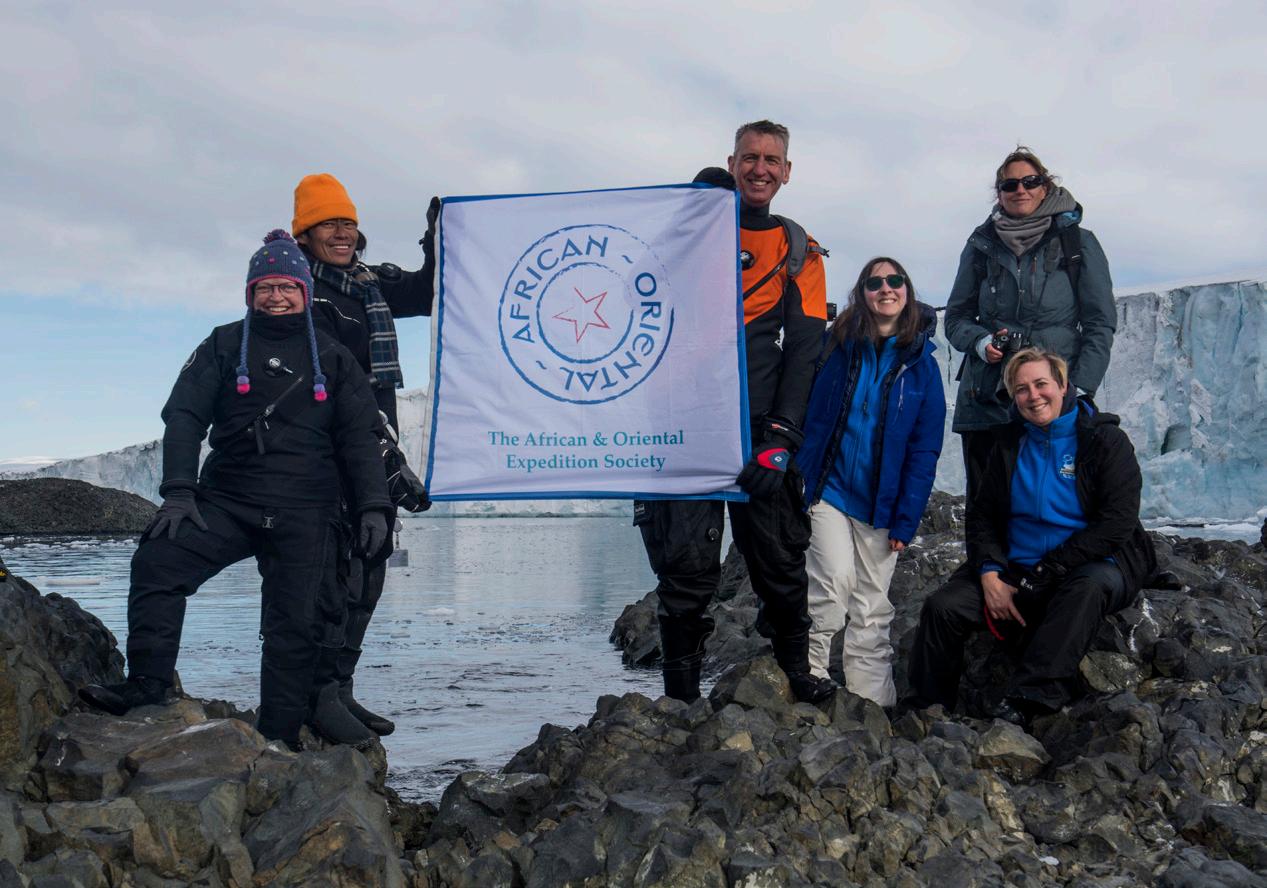
We generally had two days at sea between every set of islands to be visited, time spent writing up our experiences, cleaning our land kit for biosecurity reasons, and doublechecking our dive kit. While on deck, we watched numerous whales blow either side of the Plancius while the sun did set, albeit slowly, and more icebergs became visible.
As we steamed south-west, the onboard atmosphere changed from trepidation to excitement – we had made it out of South Georgia without a single injury. The weather held and the Southern Ocean was flat calm which meant we could steam at 12 knots with all three diesel generators running. The phrase we were to hear on the bridge was “all well3DG full ahead”
One morning, we steamed through fields of thick ice and arrived at Coronation Island in the South Orkneys. We were inside Antarctica and yet still so far from the actual continent. Our quietly-spoken Russian captain wove his way between the icebergs with supreme skill, penguins sat on the ice, seals sunned themselves and we marvelled at the weather.

Chris and Gavin look back at the recently surfaced divers.
The ice was so thick that we could not land on the shingle beach, so our dive team leader decided to dive an iceberg instead. We dropped in and circled a medium-sized iceberg: the depth was well over 100 metres and so we had to maintain perfect buoyancy. Gavin and Petra disappeared first, followed by Francisca and I. The water was green and murky, yet the iceberg was melting and creating a layer of clear water next to it. In water temperatures of between 0 º C and 2 º C, I tried to photograph ice with stone suspended in it, but with a strange current running, I found myself finning like mad to travel around the berg. After 15 minutes, we had seen enough and surfaced calmly.
Once we had clambered back onto the Zodiacs, we cruised around in the stunning sunlight before alighting on another smaller iceberg for a team photo. Standing there, I literally felt as though I had made it to the highest passes in Nepal again before we headed back to the Plancius for lunch and coffee.
That evening, Petra and Gavin held a small ’Persian Gulf Divers’ reception in their super deluxe cabin. The dive team were invited and a mysterious series of beverages appeared. I had nodded off in the library and so wandered in a little late, but thoroughly enjoyed this delayed Emirati-Antarctic divers’ meetup.
We were told that there was a slight possibility of making it to Elephant Island, depending on sea conditions and time. If the sea stayed calm and we could set off by 1500 hrs, we were in with a chance. The atmosphere on the Plancius became electric. The idea of seeing the beach where Sir Ernest Shackleton was forced to leave his men while he sailed to South Georgia to find rescue, was beyond belief.
The view from the porthole showed an apparently calm sea (you never can really tell in the Southern Ocean), and the Plancius steamed at its sedate 12 knots all morning - we were getting closer and closer.
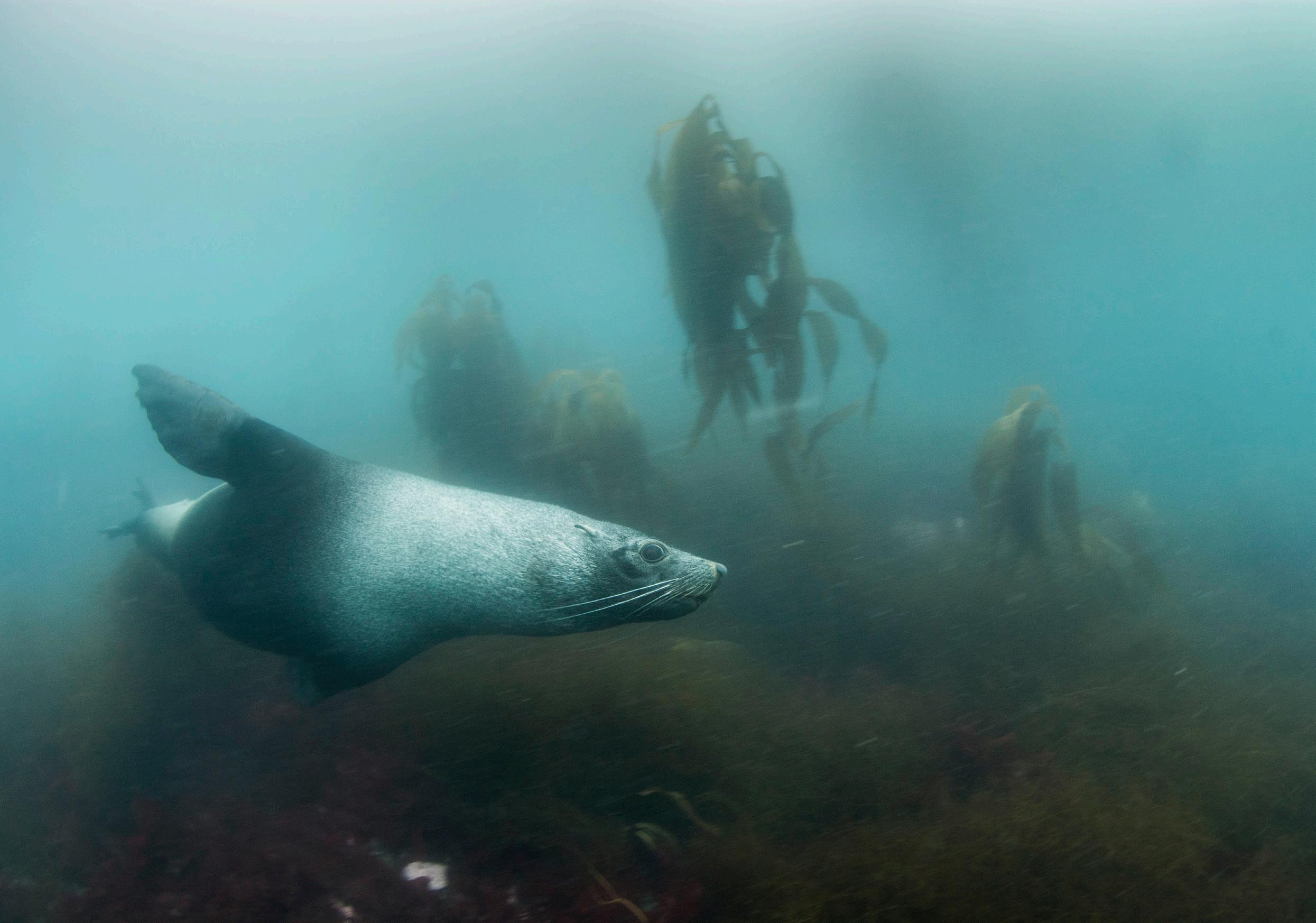
We were buzzed by fur seals on a regular basis. It took a few days to catch one on my camera.
Then, just as we approached Elephant Island, the sea started boiling with humpback and fin whales as they surfaced, blew, and dived again and again in front of us. I lost count of how many there were. In the foreground, hundreds of Chinstrap penguins filled the sea, while Antarctic terns and prions filled the sky as they dived for food. I had never seen such a proliferation of marine life. The captain decided that we could stop, and turning the Plancius in slow circles, we played with the big mammals for an hour.
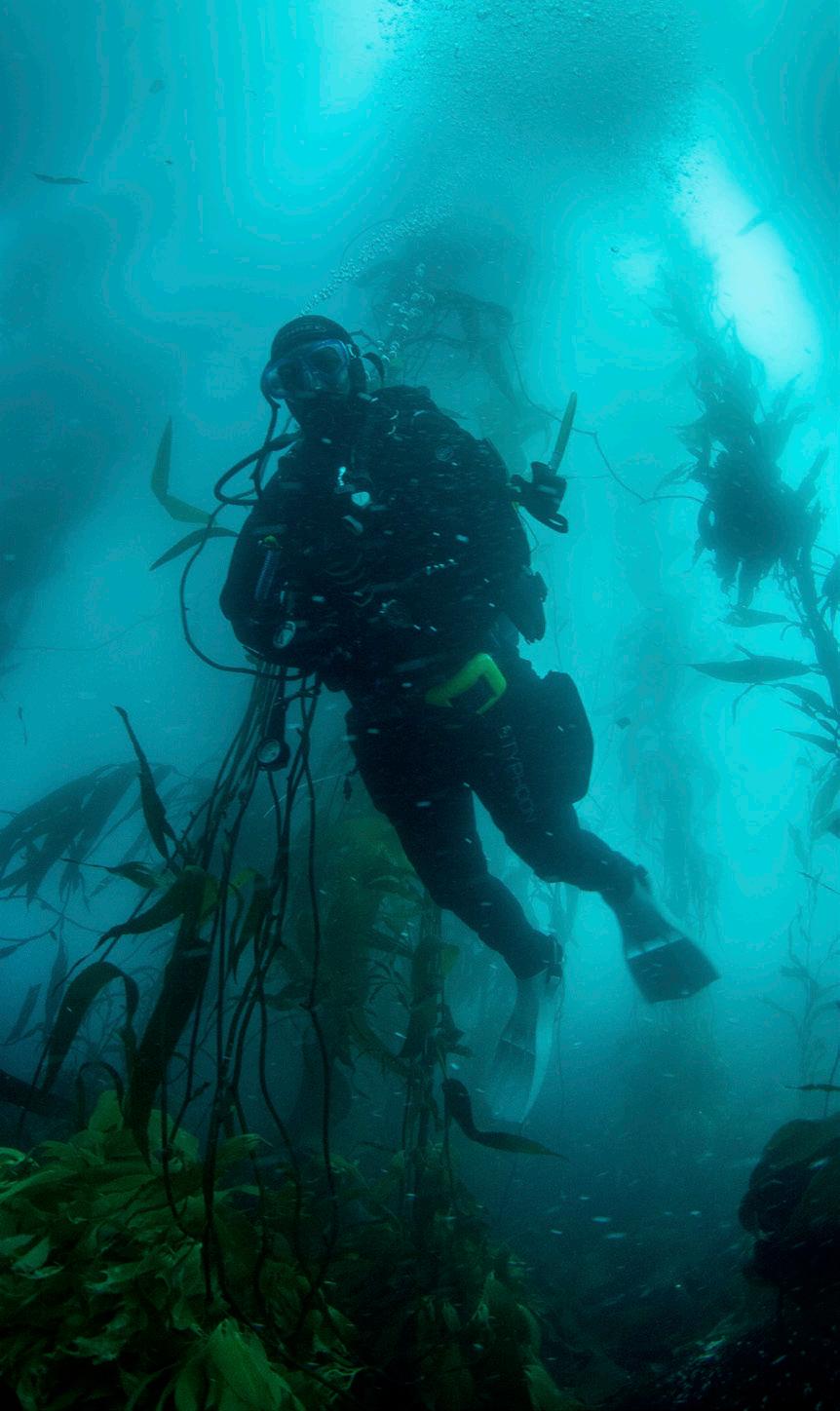
It was time to head on to Elephant Island, and we steamed into the bay opposite Cape Wilde and anchored up so the crew could launch all 10 Zodiacs. Motoring slowly, we viewed Point Wilde from both sides, then closed in to see the tiny beach where Shackleton’s men had spent 16 weeks. They lived under two boats for 4 months, eating seal and penguin and drinking Bovril. With steep cliffs and a glacier behind, and caves and a spit of land in front, their camp would have been exposed and tiny. It was an incredibly emotive place.
On the far side, we found a Leopard seal playing with the Zodiacs. He swam from inflatable to inflatable until, bored, he bit into a Zodiac full of Germans. There was mild consternation as the boat deflated and some passengers had to be transferred to others!
We left Elephant Island, and a day later, were at Paulet Island. Francisca wasn’t feeling great, so I joined Gavin and Petra once again. But once on the boat, Petra realised she had no air so I dived with Gavin. I was getting used to Gavin’s completely unruffled style. We were advised to use an SMB if the current was running. We rolled in and the current was streaming along at 3 knots. Paulet island was somewhere I had no desire to get lost on the surface, so I deployed my SMB immediately. We were diving on a steep slope, with rounded rocks, limpets, pale lobster krill, isopods, sea squirts, sea spiders and sea cucumbers, as well as numerous orange spongey things, a large white nudibranch, some small worms, a few entry holes, loads ofurchins and some small fish.

In December, South Georgia becomes a wildlife photographers dream.
My regulator grew hard to breathe on, so I pulled in a hefty breath and a bunch of ice shot into my mouth, making the regulator a lot easier to breath on. Too easy and in fact, it was star ting to free flow, so I took out the regulator and switched to the second one. Gavin turned the air off to the free-flowing regulator, but with crap buoyancy, I ended up on the surface. I ducked down to find him and we continued on.
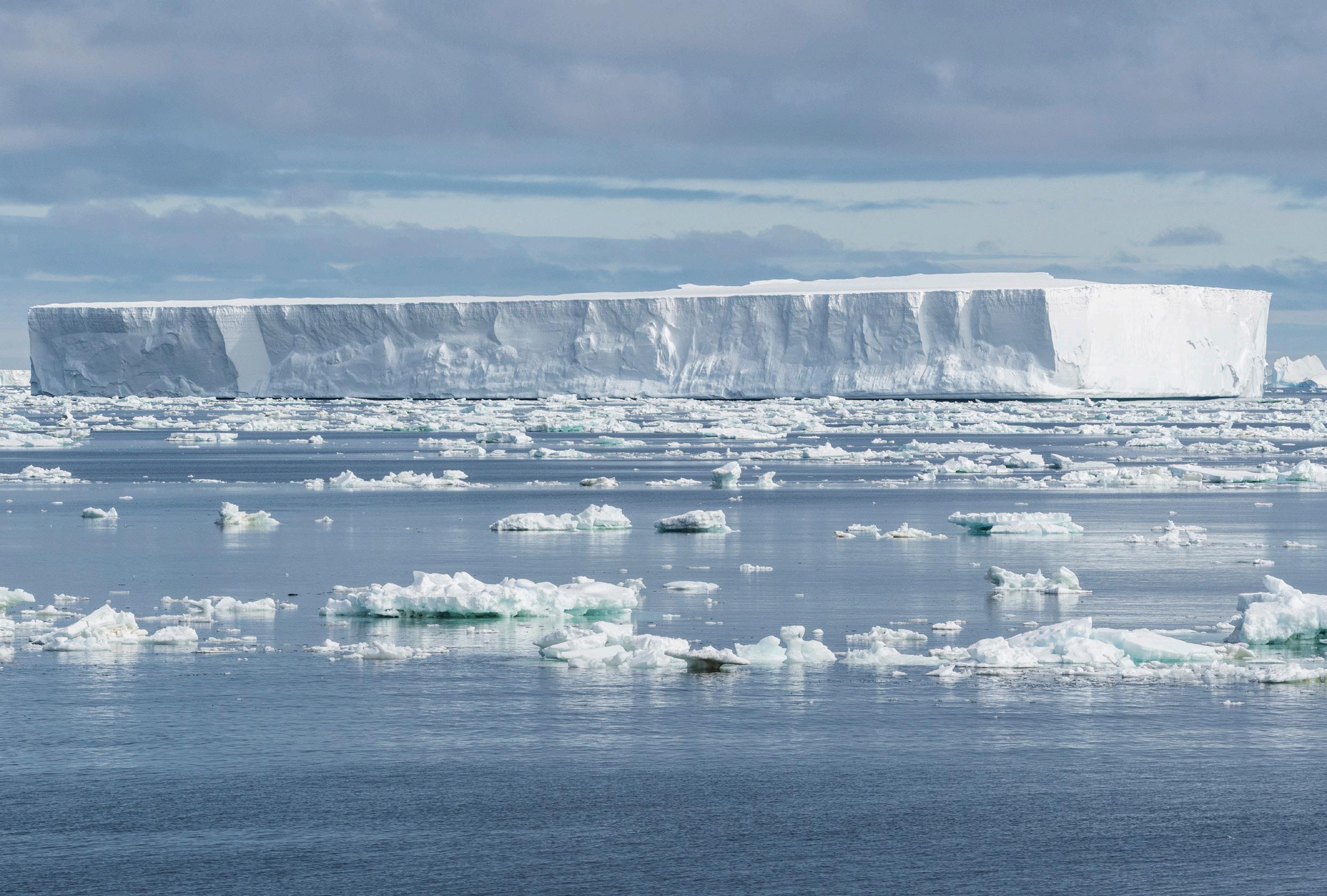
Tabular icebergs started to appear once we had left South Georgia.
After a while, he turned my valve back on again, so that I could at least see, rather than guess, my contents gauge, and we dived on calmly. By the time we finished, we had moved over half a kilometre. I ran low on air, signalled to go up, and ascended. Gavin did not follow, so I went down to get him. He then followed, but in the confusion, I dropped my Go Pro camera and Francisca’s torch. Apart from these losses, the dive had been a great success. Zodiac driver and commercial diver Chris had to help me de-kit. My fingers were so painful that I had to put them into my arctic warfare mittens and massage them, and it was a full 5 minutes before they were of any use.
Continuing on, we landed on rocky Paulet Island and saw a massive Adelie penguin colony near the ruins of an old stone hut, with an incredible frozen lake on the far side. We watched the penguins slither over the ice and waddle around in their comical penguin manner. Someone spotted what looked like a man-made path leading up a hill, reminding us that this was the island that Shackleton wanted to reach. Apart from having supplies, the landscape would have been sensational for a camp, rather than the tiny horrid space on Elephant Island.
In the afternoon, we steamed to Brown Bluff in Antarctica, a pillar of volcanic ash mixed with basalt. The cliff behind looked like the Grand Canyon, and we enjoyed summer-like weather with brilliant sunshine. We dived on an underwater ridge off Brown Bluff, with two icebergs, one grounded and one floating.We swam along the ridge and down to 14 m, spotting life everywhere: seaweed, red algae, amphipods, brittle stars, limpets and more. There were penguins on top of the ice, but not under, and we were excited to be diving on the Antarctic continent – and soon after we ascended, we were on the continent!
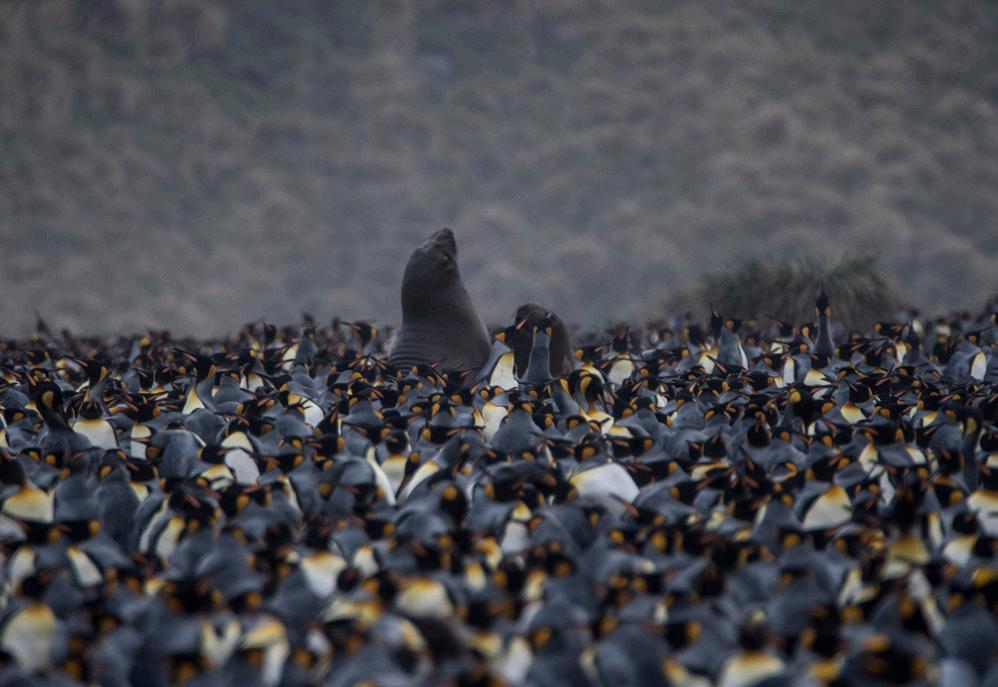
Elephant seals surrounded by King Penguins in South Georgia.
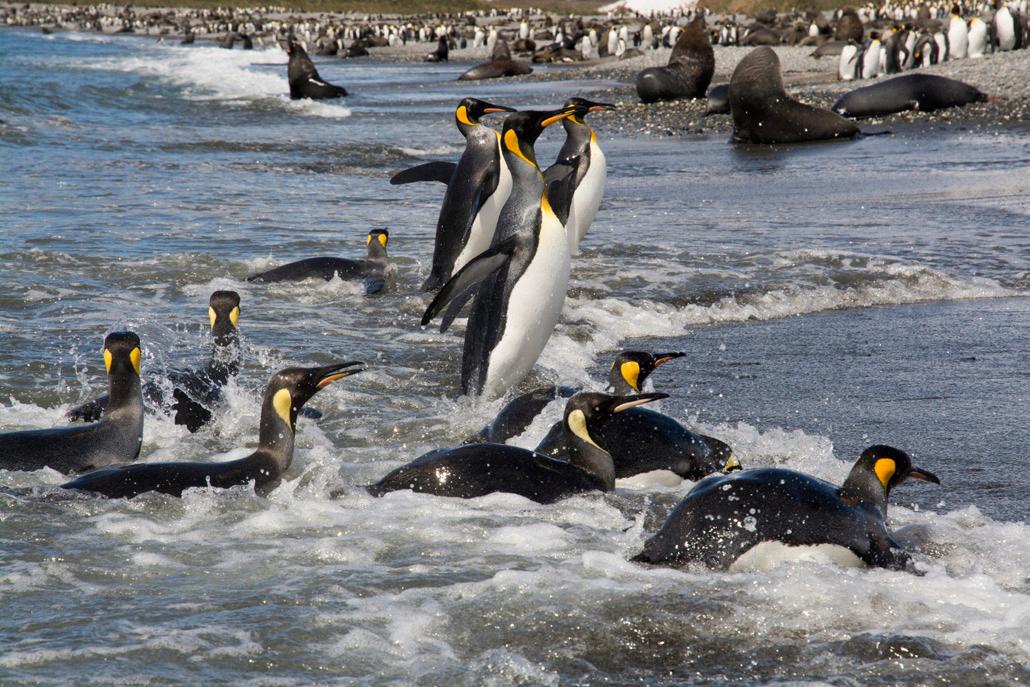
King Penguins landing to shore.
Our expedition leader decided that we should try and get to A68A, one of the world’s largest icebergs and a section of the Laarsen ice shelf that had broken off. Our skipper found it and the weather held perfectly. We cruised for about 90 nm along A68A before coming into fast and brash ice. The ship circled the biggerofthe ice floes,and bashed its way through the smaller ones, the hull clanging against larger lumps. We pushed ever southwards and the ice thickened, with Adelie penguins scrabbling out of our way onto the pack ice. Eventually, we saw a single Emperor penguin, then a second, and I took several photos, knowing that my chances of making it this far south again were slim, and I would probably never see one of those magnificent birds again.
It was time to enter the green water and its great visibility. Petra had a cold, so I dived with Gavin again. We had around 3 metre visibility but with plankton everywhere. Visibility improved at depth and there was more life on this dive than any other we had done since the Falklands.
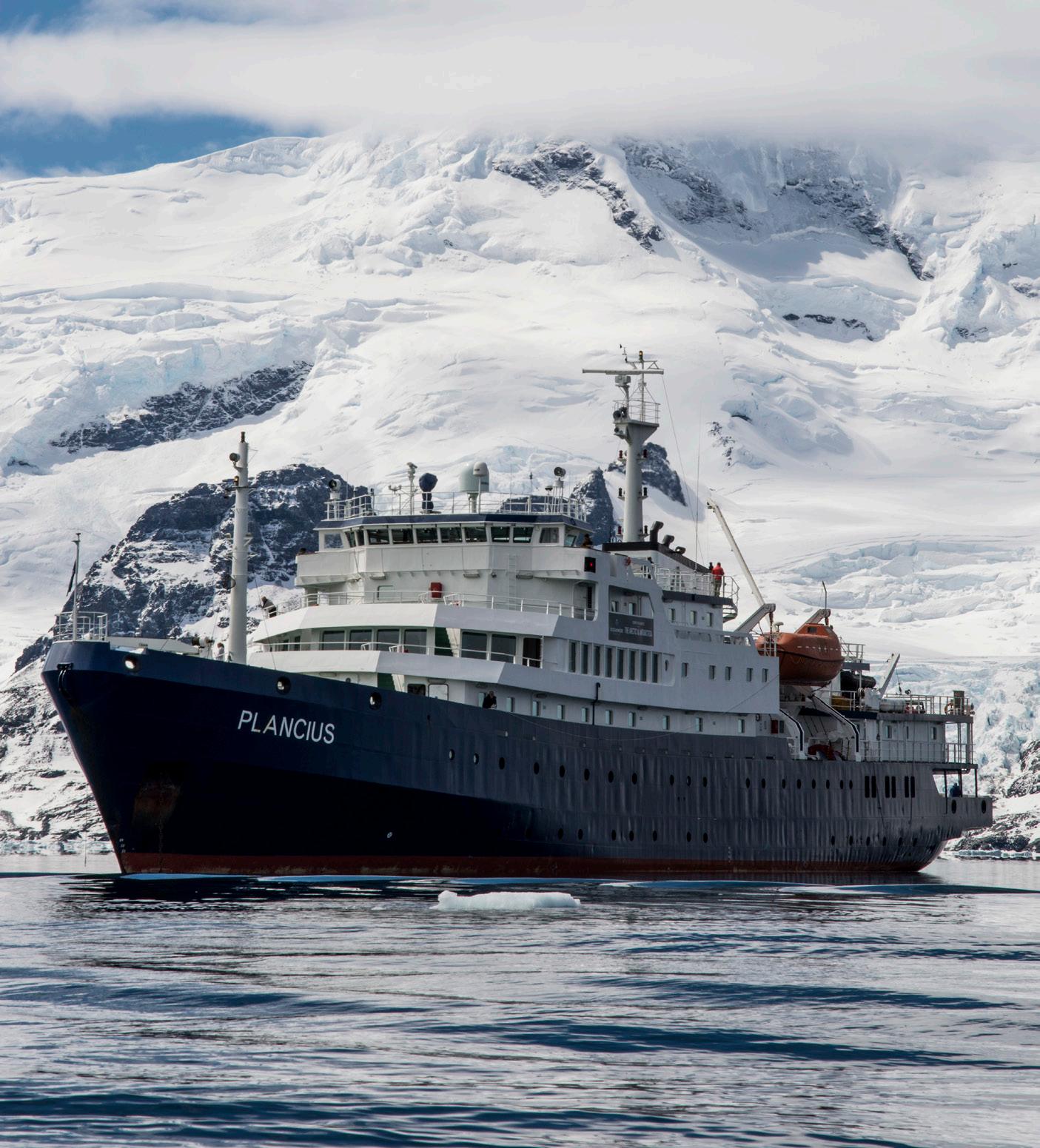
The MV Plancius at Elephant Island.
The morning saw us arrive at Yankee Harbour, a name whose provenance stumped us all. I decided to dive with the Walkers. We had crystal clear blue water with 5 metre visibility and 1 º C water temperature. This does not sound like much, but 5 m of clear water and sun illuminated water made the dive seem like paradise. The 2 degree warmer water made such a difference. I photographed fish again, krill and more fish.This was the best of Antarctic diving. With that, I was done. This dive would be too hard to beat. I washed my kit and later that day, went ashore with the non-divers. I sat on a stone in Horseshoe Bay watching whales breach and penguins natter. The expedition was over.
There remained the small matters of writing reports, editing photos and steaming for two days on the Drake Passage to start the journey home – a small price to pay considering what we had done and seen.

HOW TO GET THERE
Emirates fly to Buenos Aires four times a week. Raf and Francisca joined the African and Oriental Travel Company (A&OTC) team who arranged the midsummer Antarctic dive expedition from there. Based in the UK, the A&OTC specialises in dive trips to remote and less well-known locations, and is also an African safari specialist. The next escorted Antarctic dive expedition is in December 2021. Prices start at $11,500 per person including flights from the UAE.
CONTACT A&OTC: Email: info@orientafrica.com Call: +44 1291 570953 www.orientafricatravel.com
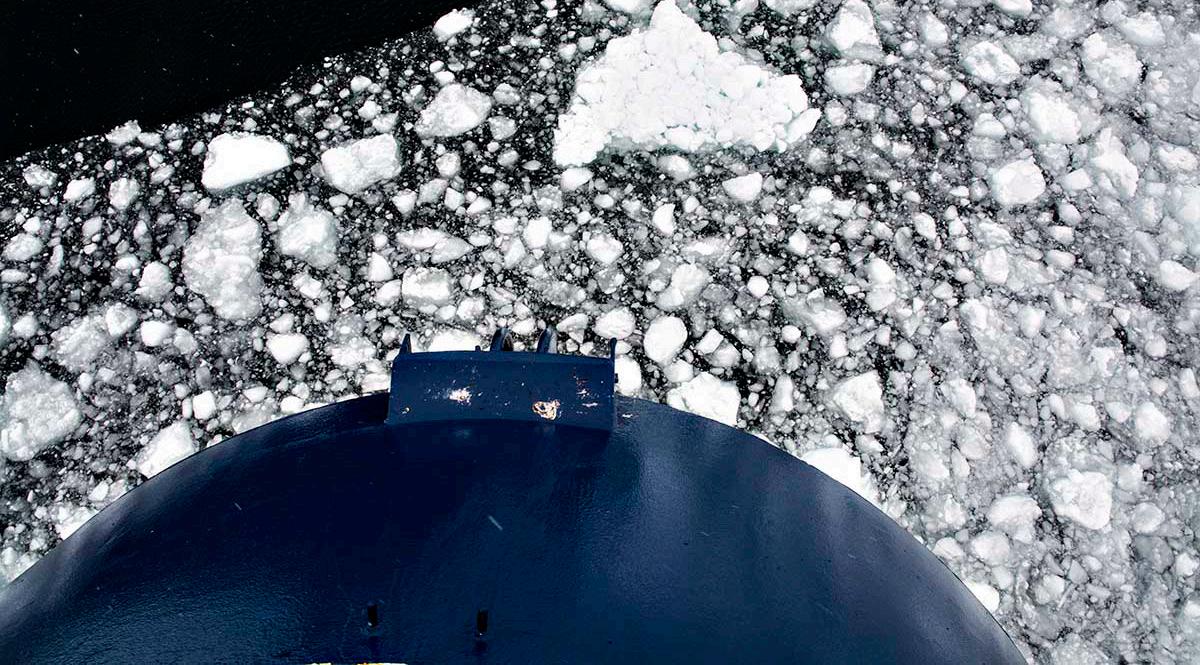
Pushing through the ice.
WHEN TO GO
Most Antarctic dive trips take place in the late season, when the whales are out, but this is not always the best time for the land based expedition goers. The African and Oriental Travel Company runs dive trips every 2 years in December. The next is in 2021.
Non-divers are more than welcome, which is why the trips are run in December in the penguin season.

One of the highlights was diving and snorkelling around icebergs.
WHAT YOU NEED
You will need to be an automous diver who is competent underwater. You will need to have 30 dry suit dives, but more importantly, you need to be comfortable with dry suit diving. More than any qualification, you need to be happy in a dry suit and to able to solve small problems and fiddle with your kit underwater. The diving is not deep, and not technical.
The best dive gear to take is simple BCD’s and two basic cold water regulators. We bought a lot of stuff from Stevie at Al Boom Diving and used aqualung core regulators. 7 mm mittens seemed to be best for the Antarctic, 5 mm gloves for South Georgia and 3 mm gloves for the Falkland’s.










